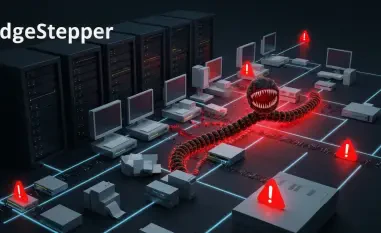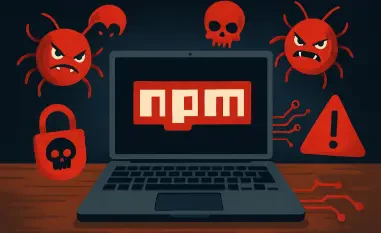In the rapidly evolving world of cybersecurity, ransomware attacks have become a prevalent threat, with affiliate models rising as a notorious technique in perpetrating these malicious deeds. These models employ a decentralized approach, akin to a cartel operation, enabling cybercriminals to customize and distribute ransomware under different brands. The DragonForce ransomware group recently exploited vulnerabilities in remote monitoring tools to deploy ransomware, exemplifying the dramatic shift toward affiliate models. This new wave signals a troubling trend, impacting industries and reshaping the cybercrime landscape.
Understanding the Structure and Impact of Ransomware Affiliate Models
The core of ransomware affiliate models lies in decentralization and collaboration, driving their resilience and effectiveness. These models allow multiple actors to participate in the ransomware ecosystem, each creating and customizing their versions of malware. This flexibility enhances the distribution reach and impact, with affiliates gaining access to a diverse array of targets. The evolution of these models has created a formidable force within the cybercrime sphere, particularly as groups like DragonForce refine their tactics and adapt to changing cybersecurity defenses.
Central to these models is a revenue-sharing mechanism that incentivizes affiliates based on their performance. Operating much like a commission-based system, affiliates earn a portion of the profits generated from successful attacks. This structure fosters intense competition among cybercriminals, spurring innovation and collaboration in developing sophisticated ransomware variants. As these models grow, they become a critical concern for those dedicated to countering the ever-present and increasingly complex threat landscape.
Advancements and Strategies Influencing Affiliate Models
Recent developments in ransomware affiliate models have showcased remarkable adaptability and strategic acumen. Ransomware groups have embraced decentralization, eschewing monolithic structures in favor of looser, more coordinated networks. This approach accelerates the deployment of malware, facilitating rapid response to emerging vulnerabilities and shifting market conditions. Notably, DragonForce’s exploitation of known CVEs in SimpleHelp showcases the prowess of these groups in navigating and leveraging technological weaknesses.
Artificial intelligence (AI) integration further shapes the trajectory of these models. AI-driven tactics enable affiliates to optimize malware delivery, scaling campaigns with precision and efficiency. These advancements compound the challenges facing cybersecurity professionals, who must now confront not only decentralized threats but also sophisticated technology that defies traditional defense strategies. The fusion of flexibility and technological prowess renders these models a formidable foe in the cyber realm.
Examining Real-World Ramifications and Examples
DragonForce’s impact underscores the real-world implications of affiliate models, with high-profile ransomware attacks targeting diverse sectors. Industries reliant on remote monitoring and management technologies found themselves vulnerable, unable to thwart breaches that enabled ransomware deployment. The retail sector in the U.K., for instance, faced devastating interruptions as DragonForce executed its affiliate strategies, demonstrating the destabilizing capacity of cartel-like operations.
Certain sectors are more susceptible to affiliate-driven attacks, particularly those with extensive digital infrastructure and remote capabilities. Managed Service Providers (MSPs) often serve as ideal targets due to their sprawling networks and the centralized nature of their services. Such entities risk becoming unwitting contributors to widespread ransomware campaigns, exacerbating the threat and elevating the urgency of reinforcing cybersecurity measures across all industries.
Challenges Confronting the Ransomware Affiliate Landscape
While ransomware affiliate models represent a burgeoning threat, they are not without limitations and challenges. Technological barriers can hinder their effectiveness, as varying security protocols and systems may resist infiltration attempts. Regulatory frameworks, while evolving, aim to disrupt and dismantle these operations, crafting legal obstacles that cybercriminals must navigate. Additionally, market dynamics may shift as companies fortify their defenses, rendering certain tactics and innovations obsolete.
In response to these challenges, various mitigation strategies have emerged. Cybersecurity alliances, enhanced threat intelligence sharing, and bolstered defenses contribute to a collective effort in countering affiliate models. Initiatives aim to restrict unauthorized software execution, enhance employee awareness, and curtail remote access avenues exploited by ransomware groups. These measures seek to diminish operational capacity, essentially undercutting the efficacy and allure of participation in the ransomware affiliate ecosystem.
Speculating on the Future of Ransomware Affiliate Operations
As ransomware affiliate models persistently evolve, their future trajectory prompts speculation and vigilance. Innovation within these models shows no signs of abating, with technological advances and strategic shifts continuously transforming the landscape. AI-enhanced delivery mechanisms and decentralized networks forecast a tumultuous backdrop as cybercriminals refine their tactics, posing ongoing challenges to cybersecurity frameworks.
Long-term impacts of ransomware affiliate models on industry defenses are profound. Companies may find themselves embroiled in offshore struggles as e-crime groups vie for dominance, leading to enhanced volatility in the digital security sphere. Consequently, proactive measures and adaptive approaches are crucial in alleviating the influences of these models, fortifying defenses against sophisticated adversaries that leverage ingenuity in their pursuit of cybercriminal objectives.
Final Thoughts on Ransomware Affiliate Models
In reviewing the notorious landscape of ransomware affiliate models, it’s evident that they wield significant power and influence within the cybersecurity domain. DragonForce’s strategic exploits have demonstrated the perilous nature and sophistication of these models, as industries bear the brunt of their devastating impact. Although the past few years have seen marked turbulence, heightened awareness and collective action remain paramount in defending against future incursions. The call to innovate, collaborate, and reinforce is clear—ushering in an era of vigilance and resilience to confront the ever-evolving threat posed by ransomware affiliate models.













